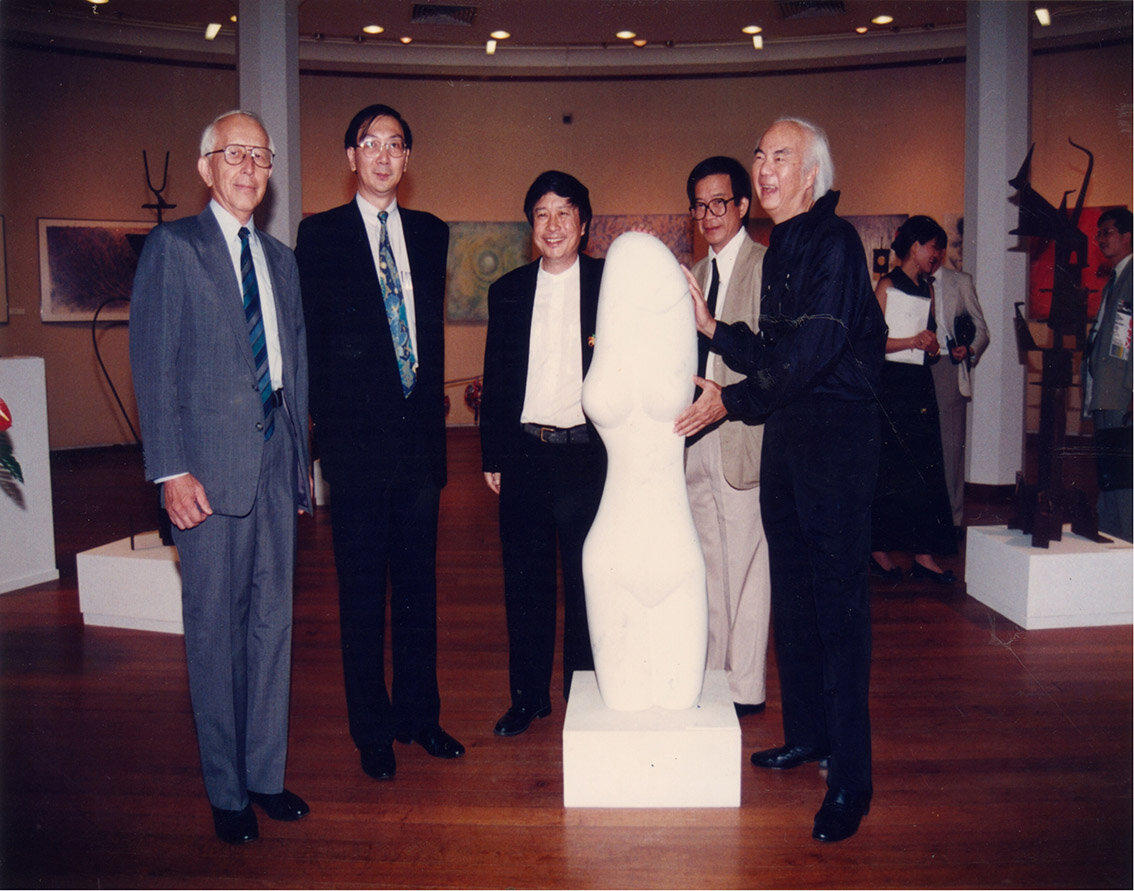Asian Planning and Architectural Collaboration (APAC)
APAC Logo Brochure Cover
APAC’s informal commencement can be traced back to 1969, when Koichi Nagashima took a break from working for Fumihiko Maki in Tokyo between 1969 to 1971 to support in the setting up of a postgraduate urban planning program at the University of Singapore. Maki was the elder founder of APAC, while Nagashima and William Lim were the unspoken leaders of the group. Sumet Likit Tri & Associates and Tao Ho Design Architects & Designers joined in 1973. Charles Correa joined some years later, with strong links to the Delos Symposium and Ekistics journal. The ideas that grew out of APAC had a strong connection to the pedagogy at Harvard, as Maki (GSD ‘54), Lim (GSD ’57, as a Fulbright Fellow, but did not complete the program), Nagashima (GSD ’64) and Ho (GSD ’64) were highly influenced by Jaqueline Tyrwhitt, Walter Gropius and other teachers. They were also exposed to influential figures such as Victor Gruen, Jane Jacobs, Lewis Mumford and others who lectured at the Urban Design Conferences at Harvard.
APAC was formed to compete for commissions for large-scale projects in Asia, in part because APAC members were critical that the processes of modernisation and urbanisation being dominated by Western experts in design, planning and policy-making. At the height of the Cold War, international organisations such as the United Nations, World Bank, Colombo Plan, Organization for Economic Co-operation and Development, Japan International Cooperation Agency adopted new postures as donor nations to bring technical aid, expert advisory, loans, training and education to assist in the growth of developing economies. These new diplomatic forms were considered soft political power, not only to keep communism at bay, but to ensure the formation of democratic nations, and ultimately to keep the developing nations as free and open markets accessible to the donor nations. APAC firms identified the need for modern professional expertise in the same way, and they boasted of similar multi-scalar expertise, from a highly integrated understanding of urban design, regional planning, infrastructure, and transportation systems design, to policy making, economic planning, systems science, and public administration. This was magnified by the fact that Asia was undergoing massive change, where the architectural scale cannot be designed in isolation from larger questions of the city and the environment. Both Maki and Lim articulated this large-scale concept vis-à-vis the “environmental” scale in their respective writings from the 1970s.
(From left to right) Fumihiko Maki, unidentified graduate of HKU Faculty of Architecture, Tao Ho, Sumet Jumsai, and William S. W. Lim at the launch of Tao Ho’s solo exhibition entitled “Painting, Sculpture, Design, Architecture" at the University Museum & Art Gallery, Fung Ping Shan Building at HKU on Sep 11, 1995. Source: William Lim’s collection.
APAC members came from a lineage of students of CIAM and Team 10 members, where they came together to share professional knowledge, build discourse and advocacy. Aware of their own elitist positions and educational backgrounds, APAC members made efforts to shed their American and European ideological roots, in order to create original scholarship through urban and architectural issues pertinent to Asia. To this end, Maki would consider some of the collaborative efforts of APAC as a version of Team 10 in Asia. In their formative years in the 1970s, APAC’s mentor Jaqueline Tyrwhitt continued to interact with APAC members separately. She would meet with them during her travels to Asia, through her advisory roles to universities and governments. Despite their professed professional interest, it was the writings of APAC members that would shed most light in the formation of their architectural thought. As their friendship was first founded on discourse and academic exchanges, first at Harvard and Ekistics, and later on platforms associated with the UN and Union of International Architects (UIA), this professional focus would gradually give way to a broader search for cultural identity in architecture. Tyrwhitt’s niece Catharine Huws-Nagashima observed that the name change from “consultants” to “collaboration” was destined, as APAC became a venue for the exchange of ideas. In fact, given the members’ intellectual and sometimes anti-establishment positions, they were better able to maintain their integrity through APAC. Each member embraced their intellectual association with APAC, while developing very successful commercial private practices within their national domains. Perhaps the anticipation of transnational projects was ahead of the times. APAC meetings would remain infrequent and opportunistic.
Despite the lack of success on the professional front, there was enough resolve in APAC’s academic and theoretical endeavours, that Nagashima could pull everyone together for two important publications—the 1980 Process Magazine Special Issue 20 featured the works of APAC members, and the 1985 APAC “Architectural Identity in the Cultural Context” symposium at the United Nations University (UNU), that concluded with the APAC Declaration. The ambitions of APAC continued at the large architectural and urban scales, but it was also moving towards the all-encompassing scale of humanity and its habitation. The move towards the highly abstract notion of “architectural identity” was, in a way, an escalation to an even broader scale. However, as an increasingly individualistic society confronted a globalised world, the notion of identity was very idiosyncratic and pluralistic. This suggests that APAC was identifying a crisis on two levels. First, the decolonisation project was still incomplete, and APAC found it crucial to assert Asianness in its search for legitimacy in architectural forms. More precisely, APAC was building up a resistance against the uniformity of globalisation and the linguistic games of post-modernism at that time (with different degrees of success). Second, CIAM and the modern movement remained the counterpoint for APAC, and this brought APAC much closer to ethos of Team 10, where there was a persistent search for a more humanist form of architecture.
Adapted from H. Koon Wee, “An Emergent Asian Modernism: Think Tanks and the Design of the Environment,” in Impossibility of Mapping (Urban Asia), eds. U.M. Bauer, K. Ong and R. Nelson (Singapore: World Scientific Press, 2020), 38-57. Last updated 6 August 2021.



